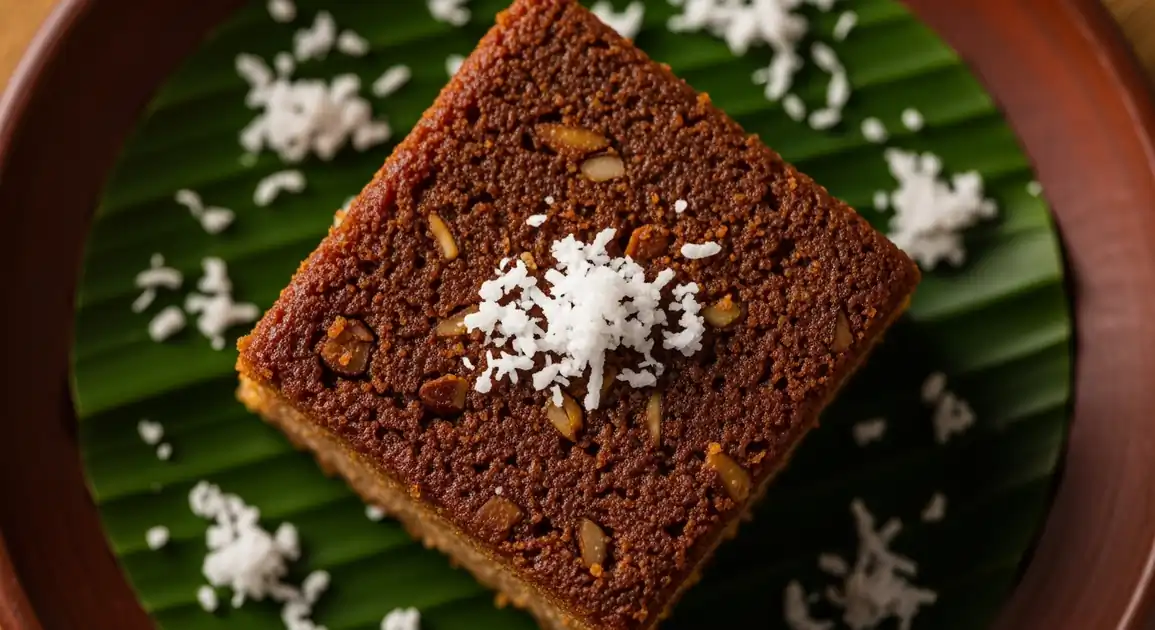Bibikkan (Coconut Cake)
බිබික්කන්

Description
Throughout Sri Lanka, Bibikkan is cherished as a traditional sweet, often prepared for special occasions and increasingly available year-round. While the recipe varies slightly by region, the southern coastal areas (including Galle) are known for producing particularly authentic versions using high-quality treacle from local kithul palms.
Dietary Information
Serving information
Serving style
Typically cut into square or diamond-shaped pieces. Often wrapped in banana leaf, paper, or plastic. In more formal settings, may be served on a plate, sometimes with a side of coconut cream or ice cream.
Quick facts
Bakeries: 7 AM - 8 PM daily. Markets: 6 AM - 2 PM, especially busy on designated market days. Tourist area vendors may operate until later, around 9 PM - 10 PM.
Safety Tips
What to Look For
-
Moist, slightly sticky texture
Quality Bibikkan should be moist throughout. Dry or hardened edges indicate it's old or poorly stored.
-
Even, dark brown color
The color should be consistently deep brown from the treacle. Unevenly colored pieces may be improperly baked.
-
Covered display
Vendors who keep their Bibikkan in covered displays protect it from insects and environmental contaminants.
-
Clean cutting implements
When the vendor cuts a piece, their knife or spatula should be clean, not sticky with residue from other sweets.
-
Noticeable spice aroma
Fresh Bibikkan has a distinct aroma of cardamom, cinnamon, and cloves alongside coconut.
What to avoid
-
Dried out or hardened pieces
Excessively dry Bibikkan is likely old. Besides affecting taste, it may indicate poor storage practices.
-
Mold or unusual discoloration
Despite its preservative ingredients, Bibikkan can develop mold if stored improperly in humid conditions.
-
Open displays in dusty or insect-prone areas
Uncovered sweets in busy markets or street-side stalls can collect contaminants.
-
Strong fermented smell
A fermented or alcohol-like smell suggests the coconut has begun to spoil.
-
Excessive sugar crystals on the surface
While a slight sugar sheen is normal, excessive crystallization suggests poor quality ingredients or improper preparation.
Price information
Price range
Budget tips
- Small local bakeries often offer better value than tourist-oriented shops, with prices around 50-100 LKR per piece.
- Markets (pola) typically sell Bibikkan at lower prices than standalone bakeries.
- Buying multiple pieces or a larger portion often results in a better price per weight.
- Family-run establishments may offer more generous portions than commercial bakeries.
Value indicators
- Noticeable aroma of spices and treacle.
- Visibly moist texture with shreds of coconut.
- Generous piece size relative to price.
- Dark brown color indicating proper treacle content.
- Served fresh rather than from refrigerated storage.
Where to Find This Dish
Market Areas
Traditional markets (pola) feature vendors specializing in local sweets.
Central Markets, Weekly Markets
Morning, Early Afternoon
Commercial Bakery Zones
Areas with clusters of bakeries often have multiple options for comparison.
Main Streets, Shopping Districts
Morning, Afternoon
Tourist Areas
Modified versions catering to international palates are common in tourist zones.
Hotel Clusters, Popular Beaches
Afternoon, Evening
Vendor Tips
- Ask when it was prepared - fresh Bibikkan is significantly better.
- Local bakeries frequented by residents often offer more authentic versions than tourist-oriented shops.
- Some vendors allow small taste samples - take advantage to assess quality.
How to Order
Regional Variations
-
Traditional Bibikkan
(සාම්ප්රදායික බිබික්කන්)
The classic version made with coconut, rice flour, kithul treacle, and spices. It has a dense texture and deep brown color.
-
Cashew Bibikkan
(කජු බිබික්කන්)
Enhanced with chopped cashew nuts throughout, adding a crunchy texture and nutty flavor to the traditional recipe.
-
Raisin Bibikkan
(රේසින් බිබික්කන්)
Includes raisins soaked in warm water or brandy, providing bursts of sweetness and a slight chewiness.
-
Semolina Bibikkan
(සුජි බිබික්කන්)
Substitutes some or all rice flour with semolina for a slightly different texture, often lighter than the traditional version.
-
Modern Bibikkan
(නවීන බිබික්කන්)
Contemporary versions may include ingredients like chocolate chips, vanilla essence, or be presented in more cake-like forms.
Cultural context
History
Bibikkan originated in southern coastal regions of Sri Lanka, where coconut palms and kithul (fishtail palm) trees thrive. It evolved as a practical preservation method for abundant coconut harvests, using jaggery as both flavoring and preservative. Traditionally prepared for special occasions and Sinhalese New Year celebrations, Bibikkan reflects Sri Lanka's historical connection to spice trading, incorporating valuable aromatics like cardamom and cloves. Over time, it transitioned from a ceremonial treat to an everyday sweet enjoyed throughout the country.
Local significance
Bibikkan represents Sri Lankan ingenuity in creating preserved sweets using abundant local ingredients. It's considered a symbol of hospitality and is traditionally offered to guests.
Eating customs
- Typically enjoyed with a cup of Ceylon tea in the afternoon.
- Cut into small pieces as it's quite rich and meant to be savored slowly.
- In rural areas, sometimes wrapped in banana leaf to preserve freshness and add subtle flavor.